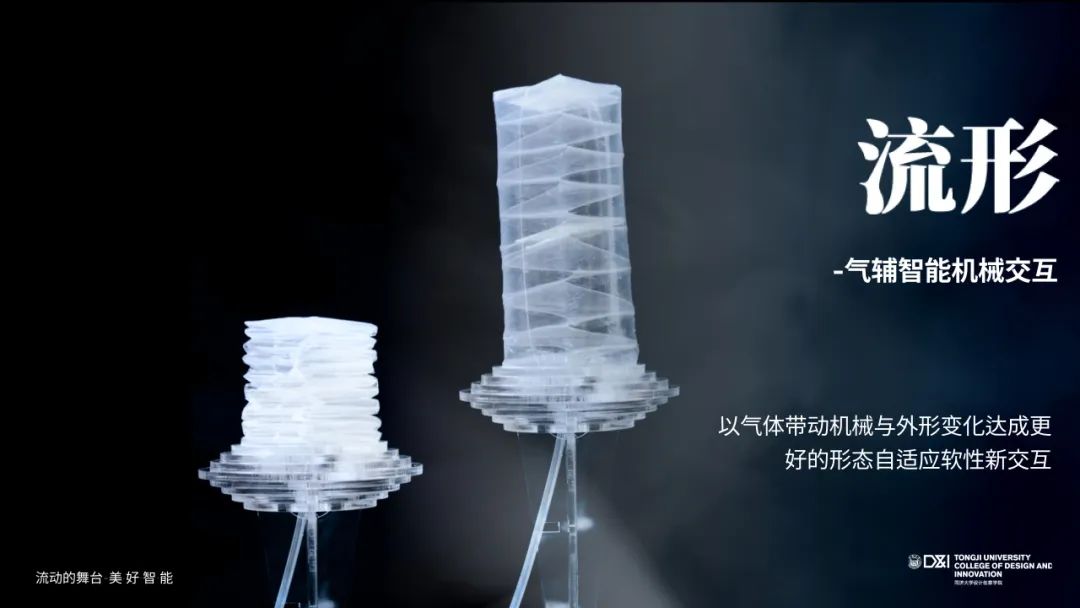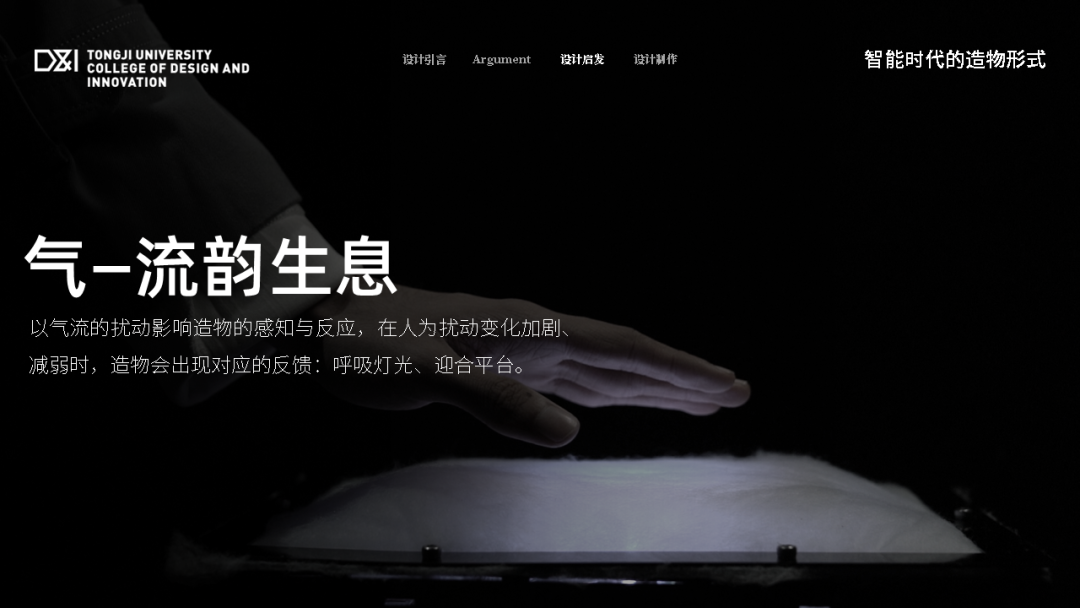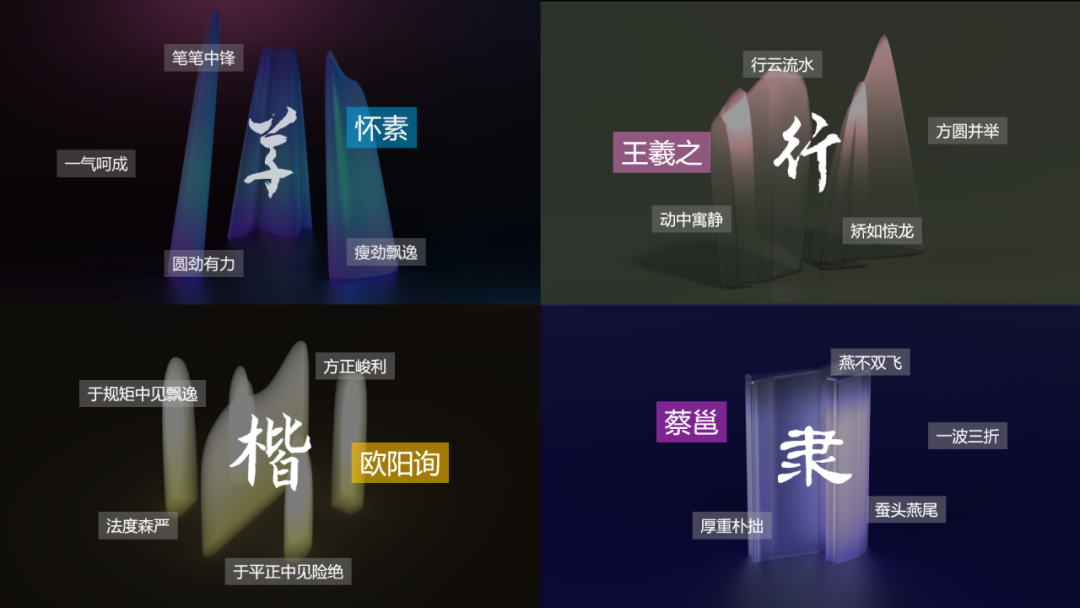同济大学第三届“同济-广汽创新设计策源营”——流动的舞台Ⅲ 课程成果
发布时间:2025年4月22日 分类:课程设计
浏览量:595
流动的舞台III
Mobile Theatre III
美 · 好 · 智 · 能
【 引 言 】
本期教学成果推送来自2021级产品设计专业课程“专业实践3(未来智能座舱体验设计)”。课程继续依托连续第三年由同济大学设计创意学院和广汽设计联合发起并举办的“同济-广汽创新设计策源营——流动的舞台III”,以 “美·好·智·能”为主题,延续面向前沿议题的产教融合设计实践育人模式,激发学生在生成式人工智能技术快速兴起的当下,通过修辞式的设计探究,追问并创造座舱体验的美好未来。
在接下去的教学成果展示中,我们将看到2021级产品设计专业的同学们以小组为单位,围绕美学体验融入日常出行、情感包容和人文关怀的个性空间、原子与比特融通的认知触点、人与智能体的共处模式和人造物与自然环境的共生相融等主题,所做的设计研究与产品原型开发。
美 · 好 · 智 · 能
BEAUTIFUL INTELLIGENCE
# Aesthetics · Thought · Life
为人造物赋予更自然的设计让生活中的美学与深刻思考融入日常
# Emotions · Care · Memory
探索个体与群体共鸣的时代创造充满情感包容和关怀的群体空间
# Autonomy · Perception · Ingenuity
追问原子与比特共生的道路促使各个维度的文化认知相互融通
# Efficiency · Function · Evolution
为商业和美的新境界开辟道路重新发现技术前沿与人文价值交汇点
未来的智能体应该拥有个性。我们设想智能代理可以通过实体的动作反馈传递情感,由此提出空间表面机器人的概念设计。空间的运动以点、线为原型,一种基于平面网格的骨架抬升,一种基于空间中点的牵拉。空间动势作为智能的骨骼,材料作为智能的皮肤,从而能够传递复杂的情感和意图。
Future intelligent agents should have individuality. We envision that intelligent agents can transmit emotions through feedback from physical actions, thus proposing the conceptual design of a space surface robot. The motion of space is based on points and lines, one is the lifting of the skeleton based on a planar mesh, and the other is the pulling based on points in space. Space electromotive force, as an intelligent skeleton and material as an intelligent skin, can transmit complex emotions and intentions.
智能时代,人们重新思考人造物的智慧属性。我们应该如何创造我们的人工环境?我们期待创造和使用什么样的物品?我们希望以设计将生物的活性、适应性和变化性应用于人造物,拓展人造物的边沿状态,打破固化的造物,赋予物品更多的开放性,让人工环境更智能地回应和满足人们的功能需求和体验需求。同时,对于产品整个生命周期可持续性规划也是我们对于人造物的反思和期许。以生物胶囊为媒介,我们做出了生物与人造物交融的新一步尝试......
美好中自有一种感觉为“逍遥”,即是一种随性的生命力,一种自由的感知力。那么,如果一个智能体拥有逍遥感会是什么状态?气体带动软性材质的收缩舒张给人带来天然的呼吸感,结合于气的智能,也许正是逍遥的落脚点。在平面交互板块上,收集到外界信号时二维产生动态形变,与人产生更具生命力的交互;在立体交互板块上,气体与机械结构结合,以高能量密度和功率密度达成塑形。气辅智能的应用与拓展将会进一步对于载具的外形与内部构造产生变革影响。在车舱中下达指令,操控气体带动纵向形变自由调控空间布局;也可以在智能感知下改变二维车舱表皮CMF,代替刚性结构进行破局,开创新研究领域。
There is a feeling of "carefree" in beauty, which is a spontaneous vitality and a sense of freedom. So, what would be the state of an intelligent agent having a sense of freedom?Gas drives the contraction and relaxation of soft materials, bringing a natural sense of breathing to people. Combined with the intelligence of gas, it may be the foothold of carefree. On the planar interaction plate, when external signals are collected, two-dimensional dynamic deformation occurs, resulting in more dynamic interactions with humans; On the three-dimensional interaction board, gas and mechanical structures are combined to achieve shaping with high energy density and power density.The application and expansion of gas assisted intelligence will further have a transformative impact on the appearance and internal structure of vehicles. Give instructions in the cabin, control the gas to drive longitudinal deformation and freely regulate the spatial layout; It is also possible to change the two-dimensional cabin skin CMF under intelligent perception, replacing rigid structures to break through and open up new research fields.
智能时代的到来将人机关系的讨论推到了前沿,但现有讨论多囿于传统二元对立思维即“技术中心主义”立场和“人类中心主义”立场。在这两种关系中,似乎都是默认在一种“人机对立”的大背景下谈论的,但这恰恰是智能时代人机关系问题的症结所在。我们希望可以突破这种传统的思维模式,将智能机器看作人类实践的伙伴,人类与机器并不是独立存在的个体,而是人机共生系统的组成部分,互利共生才是智能时代人机价值关系的主轴。综上,我们希望:建立智能功能状态的力感反馈,完善人机交互流程,创造人机协同工作体系,从而提升人类对于智能技术的信任感。力感一词通常用来描述“感觉力量或力量的感知”,我们希望通过智能所主动表现出的“力感”,来帮助人类判断何时介入智能的工作流程中。我们将“力感”分为了“发力感”和“乏力感”两个方面,希望我们在与机器协同工作时既能在其状态满满、持续发力的过程中对其充满信心,又能在其力不从心,略显乏力时进行伸出援手。
The arrival of the intelligent era has pushed the discussion of human-machine relationships to the forefront, but existing discussions are mostly limited to traditional binary oppositional thinking, namely the "technology centrism" and "anthropocentrism" positions. In both of these relationships, it seems that they are discussed in a context of "human-machine opposition", but this is precisely the crux of the human-machine relationship problem in the era of intelligence. We hope to break through this traditional thinking pattern and view intelligent machines as partners in human practice. Humans and machines are not independent entities, but components of a human-machine symbiotic system. Mutual benefit and symbiosis are the main axis of the human-machine value relationship in the era of intelligence.In summary, we hope to establish force feedback for intelligent function status, improve human-machine interaction processes, create a human-machine collaborative work system, and thereby enhance human trust in intelligent technology.The term "sense of force" is commonly used to describe "the perception of perceived power or power." We hope to use the "sense of force" actively exhibited by intelligence to help humans determine when to intervene in the workflow of intelligence. We divide "sense of power" into two aspects: "sense of power" and "sense of fatigue". We hope that when working with machines, we can not only have confidence in them while they are in a full and continuous state of power, but also extend a helping hand when they are feeling overwhelmed and slightly weak.
车是智能的载体,未来载具中的美好智能将以何种形态存在?我们认为智能不应仅局限于座舱,而应贯穿载具内外,营造统一、灵动、可消隐而又有迹可循的智能形态。“光”是智能的外化触点,我们以光引导、串联、传达信息。探究智能以“光流”的形式在车内柔性织物、硬质表面及车外大灯中穿梭流动的可能,构建内外贯通、人车智合一的未来出行体验。
Cars are carriers of intelligence, and in what form will the beautiful intelligence in future vehicles exist? We believe that intelligence should not be limited to the cockpit, but should run through both the interior and exterior of the vehicle, creating a unified, agile, stealthy, and traceable form of intelligence. "Light" is an intelligent external touchpoint, and we guide, connect, and convey information through light. Explore the possibility of intelligence flowing through flexible fabrics, hard surfaces, and exterior headlights in the form of "optical flow", and build a future travel experience that connects inside and outside, integrating human and vehicle intelligence.
《生联物界》是一系列结合生物材料创造交互体验的探索,旨在突破交互界面以无机材料为主,缺乏生命感的现状。项目由系列材料试验和装置设计组成,探索了与Scopy、生物塑料、纸浆材料、松树皮等多种材料的智能界面设计可能,产生了一系列新设计语言和加工制造技术。
Biophysics is a series of explorations that combine biomaterials to create interactive experiences, aiming to break through the current situation where the interaction interface is mainly composed of inorganic materials and lacks a sense of life. The project consists of a series of material experiments and device design, exploring the possibility of intelligent interface design with various materials such as Scopy, bioplastics, pulp materials, pine bark, etc., resulting in a series of new design languages and manufacturing technologies.
随着信息爆炸知识繁杂,创意活动中甄别信息、选择信息的重要性日益提升。而人的意识由无意识到表意识本就是与生俱来的一种遴选信息的能力。我们探究将这种潜意识的遴选机制为有意识的创意活动所用的可能。das Über-Ich是以蘑菇菌类的造型为灵感设计出的一款造梦座椅,旨在为乘客提供一种全新的旅行体验。打造一个介于现实与梦境的超现实空间,让使用者在无意识的情况下进行发散和创想。利用高度敏感的压力传感器来检测使用者的坐姿,即时分析生理特征和受力,并对应编码进行声光电与形变的反馈。而其使用过程本身也成为了一种基于无意识的创作活动。
With the explosion of information and the complexity of knowledge, the importance of identifying and selecting information in creative activities is increasing. The transformation of human consciousness from unconsciousness to ideographic awareness is an innate ability to select information. We explore the possibility of using this subconscious selection mechanism for conscious creative activities.Das æ ber Ich is a dream seat inspired by the shape of mushrooms, designed to provide passengers with a brand new travel experience. Create a surreal space between reality and dreams, allowing users to diverge and imagine unconsciously. Utilize highly sensitive pressure sensors to detect the user's sitting posture, analyze physiological characteristics and stress in real-time, and provide corresponding encoding for feedback on sound, light, and deformation. And its usage process itself has become an unconscious creative activity.
从工具诞生开始,人类都在不断运用自己自己的智慧进行各种造物活动,小到各类工具,大到建筑高楼,人类一切的造物活动都是在不断适应自然环境与变化的过程。而人类的智慧是有限的,不同的生物对不同的环境具有极强的适应性,相对而言人类则缺乏对不同的变化环境的适应性,因此我们想要探讨的是自然植物对环境的感知与适应对于未来自然、人、人造物之间关系的启发与可能性。本项目将日常环境中看不见的元素——压力、声音、光作为交互的触发尝试创造和探讨新的交互可能性。
Since the birth of tools, humans have been constantly using their own wisdom to carry out various creative activities. From various tools to building tall buildings, all human creative activities are constantly adapting to the natural environment and changes. However, human intelligence is limited, and different organisms have strong adaptability to different environments. Relatively speaking, humans lack adaptability to different changing environments. Therefore, what we want to explore is the inspiration and possibility of the perception and adaptation of natural plants to the environment for the future relationship between nature, humans, and artificial objects.This project attempts to create and explore new possibilities for interaction by using invisible elements in daily environments - stress, sound, and light - as triggers for interaction.
书法家在创作的时候通过笔锋的疏、密、浓、淡来表现节奏,将平面的东西本化,借助对章法、趋势的布局,给人带来视觉冲击。光线的历程是美学的演变,受人、时、地的技巧、物料、传播速率所局限路如同笔迹,是生动的;用看似无形,实则可见之物布局实体空间,这与中式美学中虚实相生的概念不谋而合。因此,我们想以空间作纸,灯光为墨,在天地之间呈现书法魅力。我们通过对书法单个字的字形、风格、留白、顿笔,街接等特点进行参数化分析处理,并以光线的色调、强弱、形式变化来界定具有不同功能倾向的空间,我们采用的方法是通过对书法作品的参数化分析,用光来打造书写者的书法空间。
Calligraphers use the strokes of sparsity, density, richness, and lightness to express rhythm in their creations, localizing the east-west aspects of the plane, and using the layout of structure and trends to bring visual impact to people. The process of light is the evolution of aesthetics, limited by the skills, materials, and propagation speed of people, time, and place. Like handwriting, it is vivid; The layout of physical space with seemingly intangible but actually visible objects coincides with the concept of the coexistence of virtual and real in Chinese aesthetics. Therefore, we want to use space as paper and lighting as ink to present the charm of calligraphy between heaven and earth.We conduct parametric analysis and processing on the characteristics of individual calligraphy characters, such as their shape, style, white space, pauses, and street junctions. We define spaces with different functional tendencies based on the color tone, strength, and form changes of light. Our method is to use light to create a calligraphy space for the calligrapher through parametric analysis of calligraphy works.
“在路上”并处于一个移动的空间内是一个很特殊的状态。相当于人像送外卖一样被从A送到B。但对于讲究的现代人来说,仅仅有这个结果是远远不够的。移动空间涉及到的振动可以分为被动振动和主动振动两种。前者的来源有动力部分工作产生的振动、路况和环境因素造成的振动、后者来源比较单一,多为空间内一些部件的提示提醒功能。对于被动产生的振动,我们想做的事情是筛选和收集。筛选那些在特定情景下人们乐于接收的振动信息,将它们收集起来并反馈到空间内部和人身上。对于主动振动我们想多下一些功夫。就是通过对于振动方式的设计重塑人与空间的交互方式并构建一个由振动主导的移动第三空间。
Being on the road and in a moving space is a very special state. It's like a person being sent from A to B like delivering takeout. But for sophisticated modern people, having this result alone is far from enough.The vibration involved in moving space can be divided into two types: passive vibration and active vibration. The former comes from vibrations generated by the power part, road conditions, and environmental factors, while the latter comes from a relatively single source, mostly with reminder functions for some components in the space. For passive vibrations, what we want to do is screen and collect them. Filter out vibration information that people are willing to receive in specific situations, collect them, and provide feedback to the interior of the space and individuals. We want to put more effort into active vibration. It is to reshape the interaction between humans and space through the design of vibration modes and build a mobile third space dominated by vibration.
我们结合“万物有灵,有灵皆通”,设想一种人和物互为伙伴关系的新型人、物共处模式。“灵”,作为未来人与物交互的触点,专注于人的情感体验,关注用户的行为感受、思想、情绪,人通过与“灵”的交互和相处获得情绪价值与沉浸体验,让人、与物、与超出现实的世界之间建立一种有机关系。我们借用已经融入人们生活的AR/VR,丰富交互,让人们在“灵”的帮助下能够更好地接纳自己、他物、与世界。它贯通现实、虚拟,是以为“超元”。“灵”作为一种数字生命新身份的存在,能够对人进行针对性的理解并主动交互,提供更加真实的情感体验。
We combine the concept of "all things have spirits, and all spirits are connected" to envision a new model of coexistence between humans and objects, in which they are partners. "Spirit", as the touchpoint of future interaction between humans and objects, focuses on the emotional experience of humans, paying attention to the user's behavioral feelings, thoughts, and emotions. Through interaction and interaction with "spirit", humans obtain emotional value and immersive experience, establishing an organic relationship between humans, objects, and the world beyond reality.We use AR/VR, which has already been integrated into people's lives, to enrich interaction and enable people to better accept themselves, other things, and the world with the help of spirituality. It connects reality and virtuality, and is considered a "super element". As a new identity of digital life, "Ling" can provide targeted understanding and active interaction with people, providing a more authentic emotional experience.
在智能背景下,我们的游戏机制越来越复杂,学习成本也越来越高。但同时智能体也有创造个性化交互体验的优势。我们以“乐玩”为主题,以音乐为载体,期待让更多的人能以更低的学习成本,享受更加直觉化更加纯粹的快乐,为人们带来无门槛的乐趣。
In the context of intelligence, our game mechanisms are becoming increasingly complex and learning costs are also increasing. But at the same time, intelligent agents also have the advantage of creating personalized interactive experiences. We take "fun" as the theme and music as the carrier, hoping that more people can enjoy more intuitive and pure happiness with lower learning costs, and bring unlimited fun to people.
云辞扎根于这个信息爆炸的时代,获取信息唾手可得,智能也丝毫不吝于助长我们对信息的渴望。过多不必要的情绪和信息被摄入,不属于自己圈层的信息,想法,裹挟人涌向集体情绪的洪流。我们基于正念的理念,希望创造一个供人静思,不带评价地与外界互动的空间,给予并提升人们过滤情绪,稳定情绪的能力。在系统对用户浏览信息进行简单情绪标记生成后,用户通过放大、缩小、组合等各种手势与云互动进而全部消除,使空间重归平静,也使自我重归平静。
Yunci is rooted in this era of information explosion, where obtaining information is easy and intelligence is not stingy in fueling our thirst for information. Excessive intake of unnecessary emotions and information, information and ideas that do not belong to one's own circle, carries people into a flood of collective emotions.Based on the concept of mindfulness, we hope to create a space for people to contemplate and interact with the outside world without evaluation, giving and enhancing their ability to filter emotions and stabilize them. After the system generates simple emotional markers for user browsing information, users interact with the cloud through various gestures such as zooming in, zooming out, and combining to completely eliminate them, restoring peace to the space and self.







































































































